








The magazine of the art-form of the photo-essay
“A free, really high quality photo-essay magazine. Fabulous!”
Stephen Fry. British actor, writer and film & documentary maker

Feb 2016 back issue


by Kevin Bubriski


Photographer Kevin Bubriski has been visually documenting the country and
people of Nepal since his first visit in 1975. Sent as a young Peace Corps
volunteer to the northwest Karnali Zone, the country’s remotest and most
economically depressed region, he spent three years walking the length and
breadth of the Karnali, planning and overseeing construction of gravity flow
drinking water pipelines. He also photographed the local villagers, producing an
extraordinary series of 35mm and large format black-and-white images.
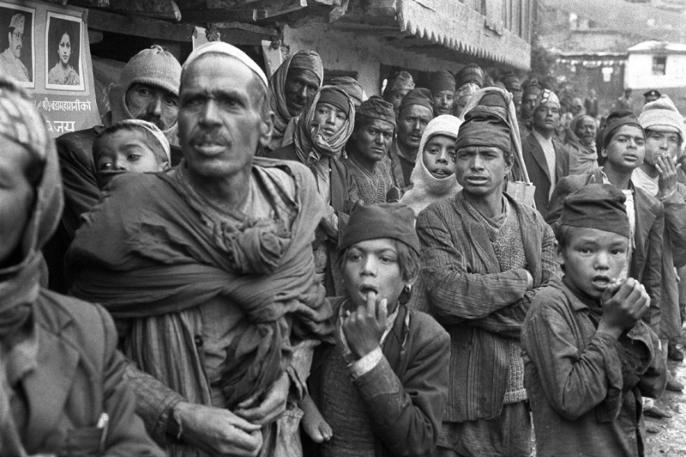
In February of 1978 Nepal’s King Briendra and Queen Aishwarya arrived by helicopter at the remote mountain outpost
town of Jumla where 70% infant mortality rates and perennial hunger was the way of life for most local people in that
northwest region of Nepal. In the faces of the locals one can see the look of surprise and reverence as the king and
queen walk down the main street of town. I had taken a few photographs of the royal couple earlier in the morning and
decided that the powerful picture was that of the crowd.
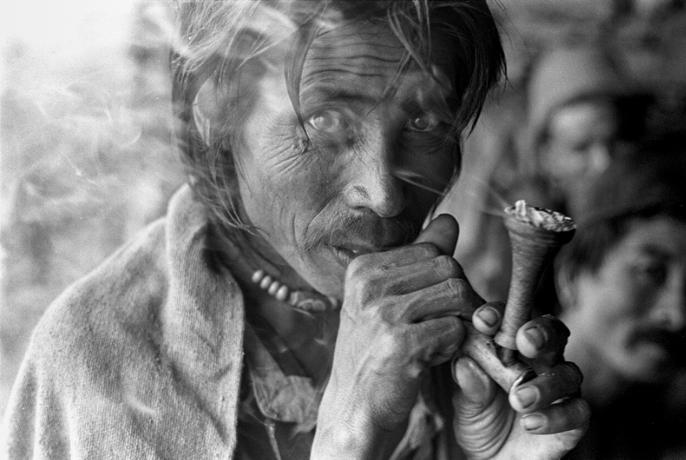
Thare, Rasuwa, Nepal 1976. A Tamang porter (an ethnic group living in the high middle hills of Nepal) takes a tobacco
break at a teashop in the village of Thare during a monsoon downpour. Before the advent of the motorway in the 1980s,
Thare was the midpoint in the two-day walk between Trisuli and Dhunche in the Rasuwa district, directly north of
Kathmandu, and all goods had to be portered for several days on people’s backs.
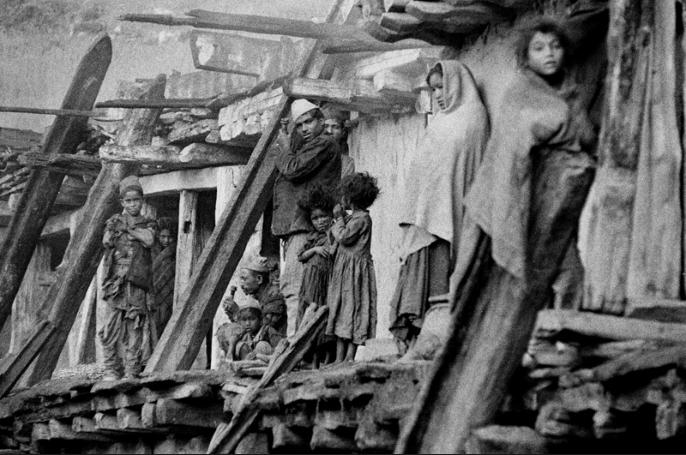
Dumbara, Mugu, Nepal 1977. The village of Dumbara, in northwest Nepal’s Karnali region, was a community of Dalit
“untouchable” families of the artisan castes of shoemakers, blacksmiths and tailors. Many of the Dalit community were
landless and worked as sharecroppers on the property of the landholders.
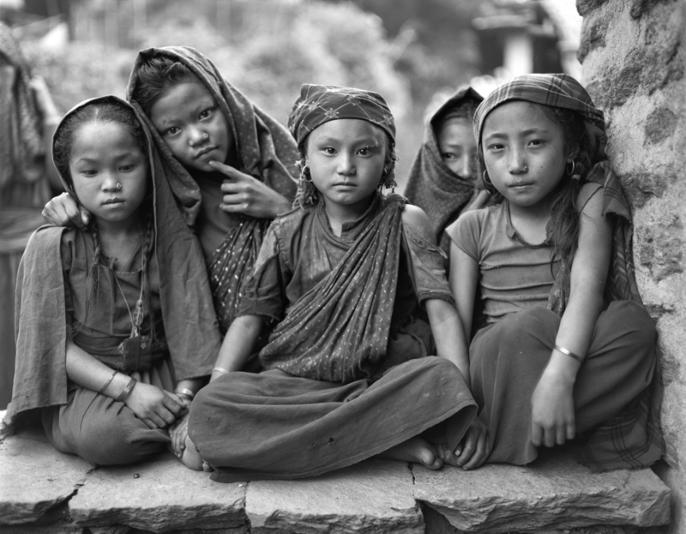
Barpak village, Gorkha, Nepal 1984 - epicenter of the April 25 quake (all houses were destroyed). Girls of the Gurung
ethnic group share a quiet moment before school starts in Barpark village in the Gorkha district, 1984.
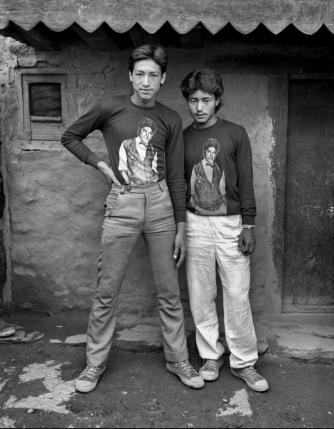
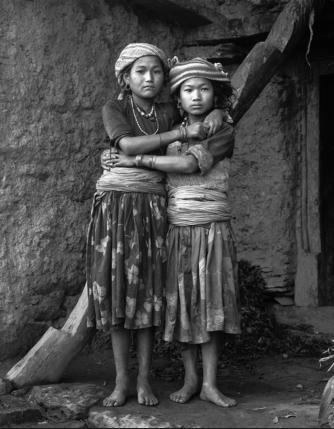
Tamang girlfriends in Yarsa, Rasuwa, Nepal 1984. These
two young Tamang girls hold each other for warmth and
out of affectionate friendship on a chilly monsoon morning
in 1984. The village of Yarsa, which had grown immensely
over the decades since 1984, was completely destroyed
by the April 25, 2015 earthquake. The two girls were
watching me photograph the rice terrace landscape when
I looked over my shoulder, saw them, asked them to hold
still for a minute and merely swiveled the view camera on
the tripod head to make the picture.
Newar Cousins, Jumla Bazaar, Nepal 1985. These
cousins of the merchant Newar ethnic group are the sons
of shop owners in what was a remote outpost town in
Nepal’s most impoverished region of the Karnali Zone of
northwest Nepal. By 1985 television and VHS cassettes,
powered by a mini hydroelectric project, had just arrived in
Jumla and the one dirt floor video parlor played Michael
Jackson’s “Thriller” regularly.
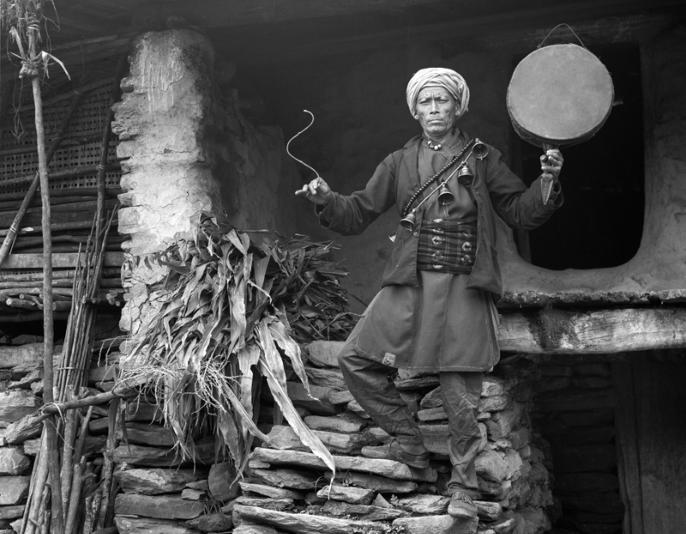
Tamang shaman in Yarsa, Rasuwa, Nepal 1984. The shaman Shing Tchor Tamang on the porch of his house, where
he and his family live and where he works, healing and performing exorcisms, displays his shaman bells and drum
which he use to induce a trance state for his shamanic practice. The village of Yarsa, which had grown immensely
over the decades since 1984, was completely destroyed by the April 25, 2015 earthquake. This photograph was the
result of Shing Tchor insisting that I come to his house and immortalize him with the photograph.
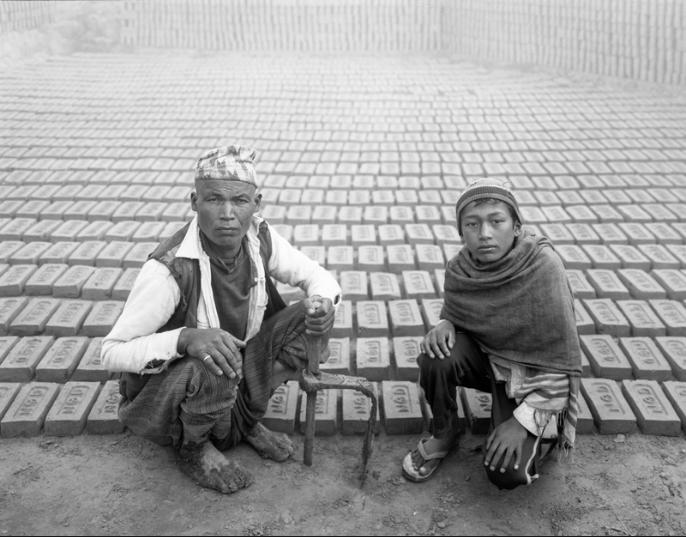
Father and son brick makers, Bhaktapur, Nepal 1985. The Newar father and son work together making mud bricks on
a foggy chilly winter morning in the Kathmandu Valley. In 1985 child labor laws were lax if at all and it was not unusual
to see children working at all sorts of labor.
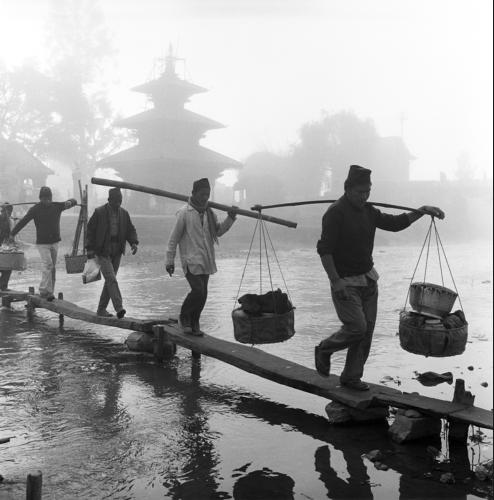
Winter bridge on the Vishnumati River, Kathmandu, Nepal. Urban Newar men, shouldering carpans, head out over a
delicate improvised plank bridge in the early morning fog to work in the neighboring vegetable plots and fields or
head home from selling their produce in the Kathmandu morning market. In 1987 urban sprawl had not swallowed up
all the prime agricultural land surrounding the ancient city of Kathmandu and rice terraces and vegetable plots existed
just a few minutes walk from downtown Kathmandu. Now the Vishnumati River is a stagnant place of waste with
highways on either side of it and the agricultural land at least an hour’s walk away.
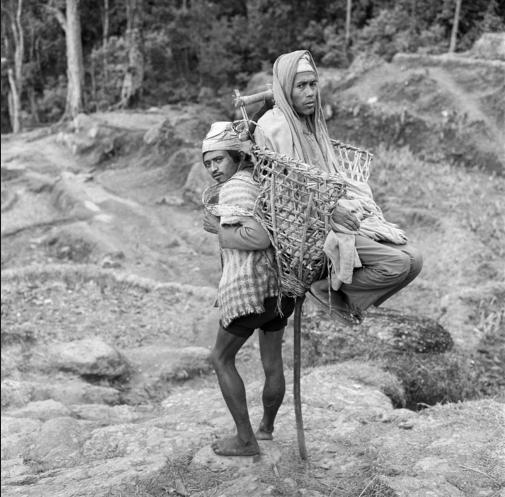
Human ambulance, Sankhuwasabha, Nepal 1987 A sick man in 1987 is portered for two days from his village to the
hospital south in Khadbahri. Where the infrastructure of motor roads is absent in the mountainous landscape of Nepal
the romantic notions of mountain life is easily forgotten and instead filled with hardships where everything must be
carried on one’s back.
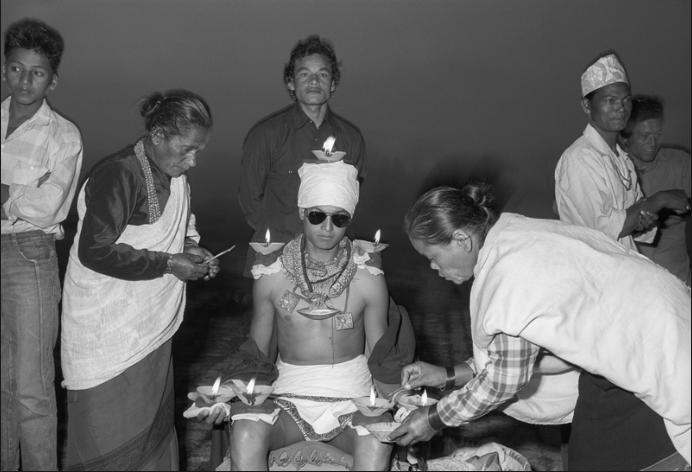
Penance, Bhakatpur, Nepal 1989. At the time of the Desain harvest festival the Hindu Newars of Bhaktapur participate
in a ritual of penance where one male member of a family will absolve the entire family’s bad karma of the year through
the night long ritual of sitting as a deity with oil lamps placed on the body and kept alight all night long. The sunglasses
are a modern touch to the ancient ritual.
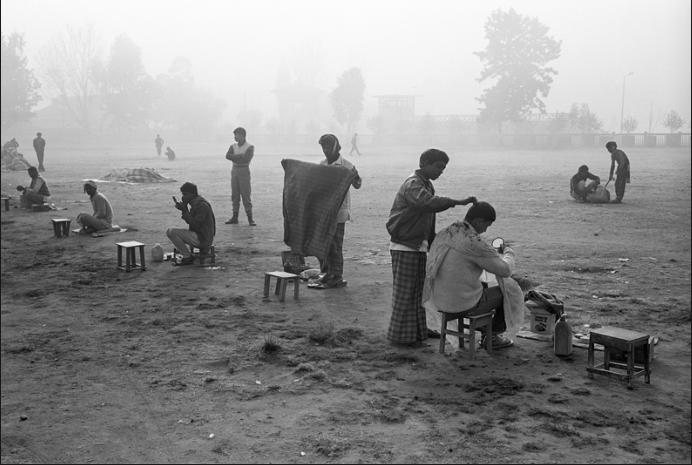
Tundikhel, Kathmandu, Nepal 1989. Barbers await clients in the early morning winter fog on the large open Tundikhel
field in the center of Kathmandu city. Thought in mythical times to have been a playground for deities, the Tundikhel
has been used for commerce, military parades, political rallies, and even rock concerts. Immediately after the 2015
earthquakes struck, the Tundikhel became a sprawling tented camp where Kathmandu residents could take refuge
away from their damaged homes, unstable and still dangerous during the countless aftershocks, which continued for
several weeks after the first earthquake.
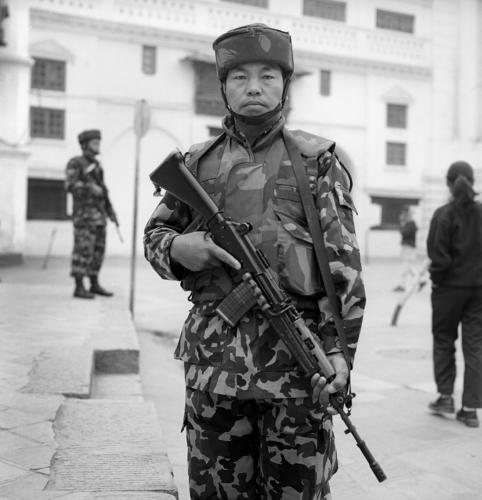
Hanuman Dhoka, Kathmandu Durbar Square, Nepal 2005. A Nepali government soldier stands on duty in front of the
historic Hanuman Dhoka palace. In February 2005, due to heightened threat of Maoist attacks in Kathmandu and
throughout the country in the ninth year of the civil war, King Gyanendra declared “Emergency” and consolidated
political control of the country.
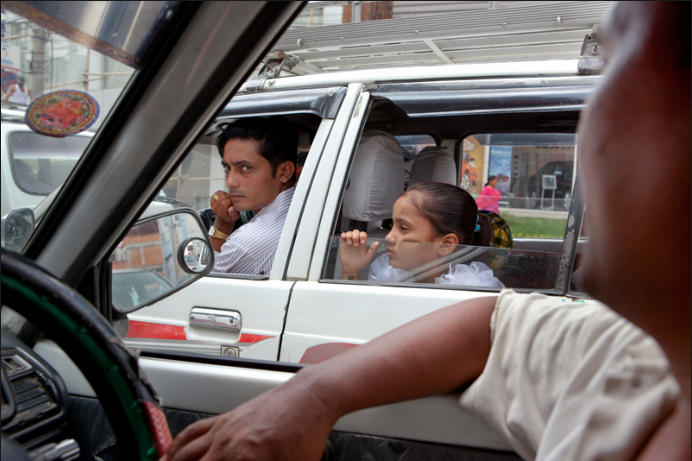
Taxi, Kathmandu, Nepal 2010. A passenger wearily eyes the photographer’s camera while his daughter watches the
stalled traffic ahead of them. The streets of Kathmandu were increasingly jammed with traffic up until the Nepal /India
border blockade that began in September 2015.
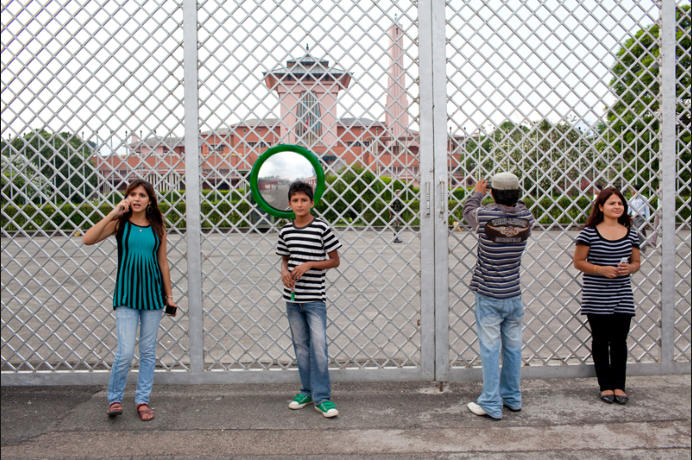
Royal Palace Museum, Kathmandu, Nepal 2010. Young Nepali tourists photograph each other at the Narayanhiti Royal
Palace Museum. The palace, including the royal bedroom and the demolished pavilion where the June 2001 massacre
of the entire immediate royal family occurred, is now open to the public.
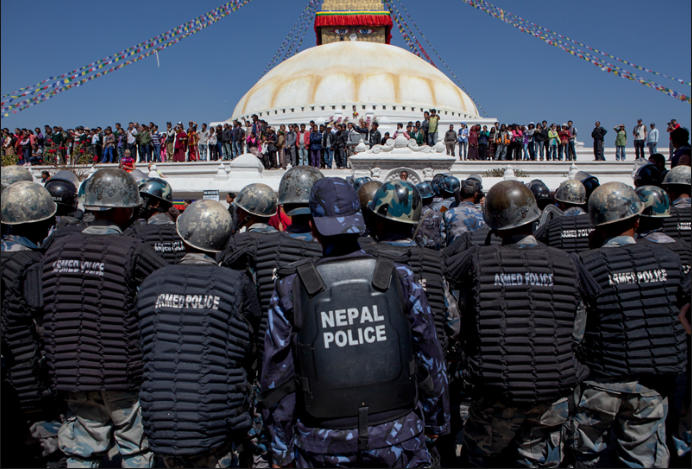
Boudhanath, Nepal 2011. Tibetans stand on the mandala-shaped Boudhanath stupa on the morning of anniversary of
Tibetan Uprising Day under the watchful eyes of armed Nepali police. In recent years, due to the Nepali government’s
interest in long term relations with China, their powerful northern neighbor, the Tibetan community has felt pressured
by the Nepali government to conform to Nepali authority and to quiet their public admiration and support of the Dalai
Lama. It is not unusual to see a large Nepali Armed Police presence at the Boudanath stupa watching over the
Tibetan community.
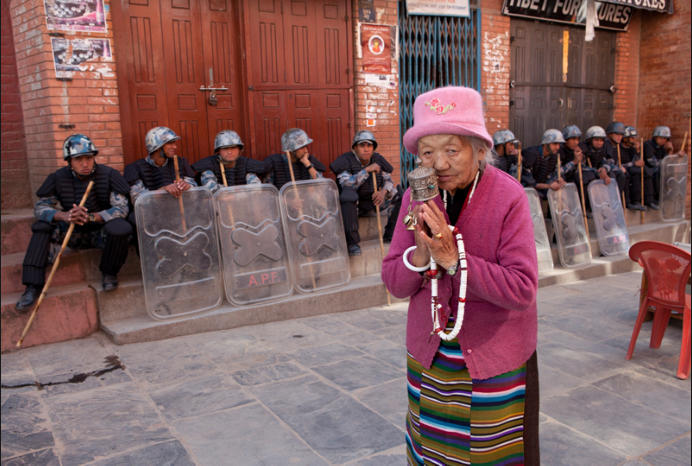
Boudhanath, Nepal 2011. An elderly Tibetan women with prayer wheel and rosary holds her hands in prayer as she
enters the Boudhanath stupa area on the anniversary of Tibetan Uprising Day , while Nepali police await a call to action.
In recent years, due to the Nepali government’s interest in long term relations with China, their powerful northern
neighbor, the Tibetan community has felt pressured by the Nepali government to conform to Nepali authority and to
quiet their public admiration and support of the Dalai Lama. It is not unusual to see a large Nepali Armed Police
presence at the Boudanath stupa watching over the Tibetan community.







